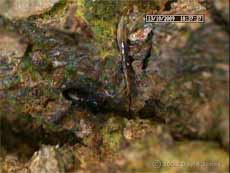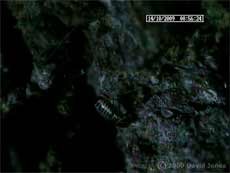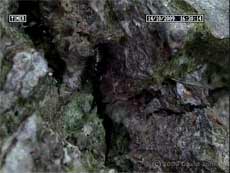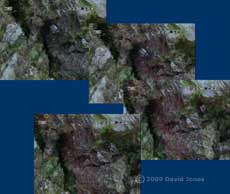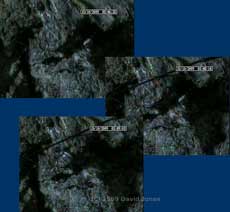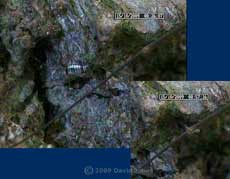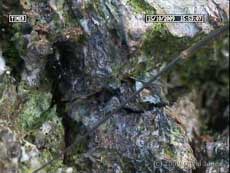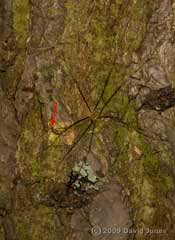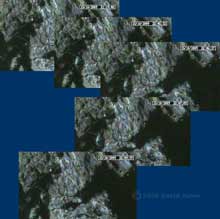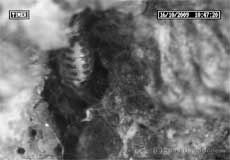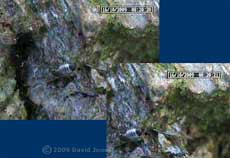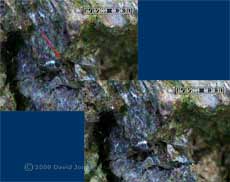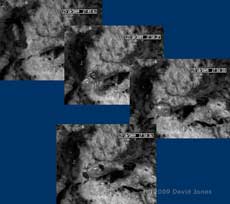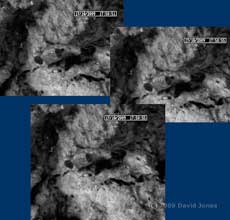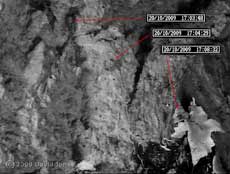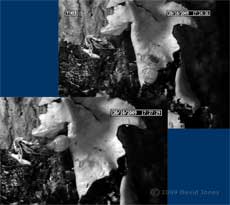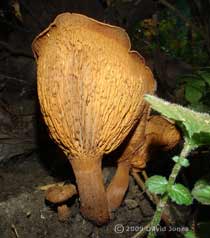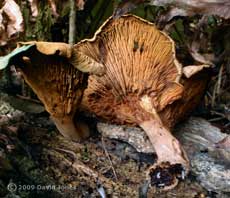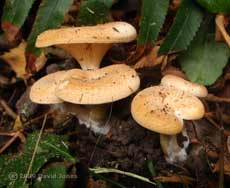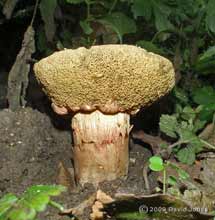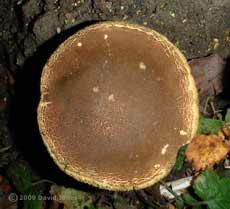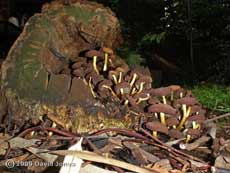Go to the last entry on this page .....Go to previous entry14 October - Just when I felt that I was getting back into a more active period, over the last week I have had a struggle to get much of anything done. Anyway, the last week began wet but the last few days have been dry with some sunshine, although today was mainly cloudy. The temperatures have started to drop enough to need some heating at home, although I'm afraid I've taken the easy option so far of using the central heating rather than the log burner. During the decorating, the veranda had become a bit of a dumping ground and I needed to tidy it. That included shifting numerous oak logs out into the garden, checking them as I did so - there are barkflies on nearly all of the logs. The P. rostocki that I monitored seems to have disappeared completely, but I found another one and set out to monitor it. Things didn't get off to a good start when, like the first one, it disappeared somewhere on the log and stayed out of sight for a couple of days. It reappeared two days ago, having created a silk shelter at the end of a crack in the bark, and a cctv camera has been trained on it since the evening of the 12th. That evening it didn't leave the shelter despite a period of activity between 8.50-9.45pm. It was active again between 2.35-2.50am. It first left the shelter at 4.47am when it went less than a centimetre away to feed before returning to the shelter at 5.41am, remaining active for the next 45 minutes.
Once it settled down at around 6.25am it remained more or less motionless for the rest of the morning. That state continued even when this insect larva decided to graze just a couple of millimetres away ( remember, rostocki is just 2mm long).
At 2.38pm it reversed out of the shelter and produced a faecal sac. Unfortunately the image was too out of focus to tell if the pellet was projected as described previously. Once under the silk again it kept still until around 4.45pm when it became active again. It left the shelter at 4.50pm and spent a short time wandering over the small area covered by the camera before starting to graze for the next 35 minutes. When it finished it returned to the shelter where it appeared to work on the silk for nearly half an hour before settling again. It left again at 9.46pm for a very brief excursion, and then spent a bit more time working on the silk canopy before settling again. Yesterday afternoon, as part of the tidying up of the veranda I reorganised the cctv arrangement. Up until then the camera had been mounted on a tripod. As well as taking up space on the veranda and being easily bumped accidentally, it also meant that every time someone walked across the veranda the vibrations caused played havoc with the image. Now, the camera is mounted on a focusing rail on a tripod head that is bolted to a small steel framed table. With the log also on the table the vibration problems are more or less cured. Also, the log is now standing on end ( as it would have been on the tree).
Last night, rostocki headed out to feed at 12.56am. This session lasted some forty minutes before it settled under the silk once more. The blue tint in this image is produced by the LED light bulb I'm using for this exercise.
At 9. 52am there was another potentially disturbing moment when another barkfly (poss C. questfalica) arrived just above the crack, although it turned away and rostocki didn't flinch. During the rest of the morning there was only a short, five minute period of activity. And things stayed quiet until late afternoon.
To put that into some perspective, while it is difficult to be precise in a situation like this, at the plane of focus (where objects appear sharpest in the image) the camera lens covers an area of around 10x13.5mm. At no time today has rostocki ventured beyond these limits, although I have now rotated the camera slightly to cover more of the area covered by algae to the right of the shelter.
Rostocki returned to its shelter at 5.30pm and hasn't moved since - at least, until 8.45pm (which is the time as I write this. Something I haven't seen this time is a clear image of the projectile defecation that I witnessed with the previous rostocki. However, with the more stable camera arrangement now in place, I hope to be monitoring it for a while (as long as it doesn't decide to leave, as the first one did!) - I'll try not to bore you with too many details!
15 October - A day which started with hazy sunshine but which became cloudy in the afternoon. The barkfly saga continues, with a slight distraction today -
About 18 minutes into that session there was an intrusion into the frame by a leg which settled. Despite this, rostocki continued to eat for another two minutes before returning to its shelter.
When daylight arrived the leg was still visible, having moved slightly, but rostocki ignored it when going out for a feeding session between 8.24-9.01am.
Both creatures were still in place when I recorded this image in the late afternoon.
And what did the leg belong to? - A harvestman. An initial search suggests that it is Leiobunum rotunum, an abundant species. Like all harvestmen it will prey on small insects, so perhaps rostocki was taking a chance in moving about below the leg! In this picture I've highlighted the approximate area covered by the cctv
camera to give an idea of its size. Its body is just over 5mm long and the
longest legs must each be the best part of 6cm in length - it's a giant compared
with rostocki, whose hiding place is indicated by the red arrow.
The book I'm looking at ('The Natural History of the Garden' by Michael Chinery) suggests that it is a species that is an active hunter by day and by night, although this one didn't move from the time it arrived at 3.47am and when I accidentally disturbed it while trying to measure it at around 4.30pm. At 4.40pm rostocki climbed out of the shelter, turned around and produced a faecal pellet (as far as I can tell, for the first time today). Unfortunately, its rear end was over a dark background and even with the timelapse recorder recording at 50 frames per second I couldn't make out whether or not the pellet was projected. At 5.23pm it suddenly decided to leave the shelter again, this time heading going down the log and out of sight of the camera for the next 23 minutes. On its return it headed straight back into the shelter and settled immediately. So far today I haven't seen any substantial activity inside the shelter. After dusk it moved deeper into the back of the shelter so that it became hidden from view for the first time.
16 October - A grey, although quite bright morning. Last night the temperature low was 10C and as we approach mid-day it has only risen by 3 degrees. Rostocki continues to grab my attention. Having done very little in its shelter during the day yesterday, at 10pm it started 'working' busily, and at 10.45pm I'm almost certain that it laid an egg.
First, rostocki emerged from the upper, hidden part of the shelter and paused, facing downwards. A short time later a shiny (moist?) object emerged from the rear of her abdomen - certainly too big for a faecal pellet (also, these are never shiny). Then she seemed to place the object against the surface, and as she waited the shine slowly disappeared, presumably as the surface of the egg dried out.
Rostocki eggs are black, making it difficult to see in the shadowy situation that exists here. I don't want to risk disturbing her, so I am resisting temptation to start shining a bright light onto the area. I've now replaced the colour camera with a black and white camera and I will add some infra-red lighting before this evening. However, at the moment, even this camera isn't producing an image that safely confirms the presence of the egg.
Anyway, after that event had occurred, activity in the shelter continued fOR another ten minutes before she left at 10.55pm. She climbed up the log and disappeared from view for around five minutes, arriving back in the shelter just after 11pm. She left again at 1.52am, this time disappearing downwards and not returning from this excursion for 41 minutes.
At 8.20am she emerged just briefly to produce a faecal pellet, which I think was projected away as described previously. As usual, she climbed out of the shelter and turned around before producing the pellet.
Once it had emerged, it remained attached to the end of her abdomen for another ten seconds before it suddenly disappeared. The two images shown here were captured 1/50sec apart, and there is no sign of the pellet in the second image. With the barkfly perched on a vertical surface, if the pellet had just fallen away I would have expected to see at least a blurred image of it in a subsequent frame, but I cannot see any signs of it at all. I think I need one of those high speed cameras to finally solve this one! After returning under the silk canopy she did not move from her resting position in the shelter all morning. There was no further activity until she left again briefly to project another feacal pellet at 5.22pm. The evening saw no activity by her.
17 October - Another dry day with some sunshine but a high temperature of just 11C after an overnight low of around 7C on our veranda. Perhaps it reflects the colder night, but rostocki was not active during the night, apart from a bit of movement within the shelter at 10.52pm. Its first trip out today was at 6am when it left just long enough to produce a faecal pellet. At 7.43am it left again. This time it headed down the log and disappeared for the next 52 minutes during which time I must assume it was feeding.
Once it returned from that outing it stayed put in the shelter for the rest of the day, until 5.49pm when it again climbed out to produce a faecal pellet. This followed the usual pattern as rostocki climbed out and then turned to face the shelter.
Then it raised its rear end and a pellet was produced which remained attached to the abdomen for a short time (nearly 5 sec this time) before it disappeared. Again, analysis of the frames gives no indication of where the pellet travels to once it has been projected. If you look at the large images I have included the three full frame images around the moment when the pellet disappears. The dark area below the barkfly is under an overhang and it is very unlikely that the pellet could have gone there.
The cctv image includes an area of about 11.5x9.5mm, and in this sequence of images the rear of rostocki is about 5mm from the right edge of the frame. If my observations and calculations are correct that would mean that the pellet is projected at a speed of at least 25cm/sec! Rostocki didn't leave again today, but at 8.47pm it started working on the shelter canopy, adding more silk towards the lower end. This activity came to an end at 9.33pm, and Rostocki settled down for the night.
18 October - A brief entry - A dry day, and after a chilly night with a low of 3C the temperature got up to 13C in the afternoon. At 3.20am rostocki spent about 10 minutes moving about in the shelter but then became still again until she appeared to get ready to leave at 7.50am. She waited until 9.10am before she actually left, heading down out of of view. This outing lasted 50 minutes and she was settled back in the shelter at 10am. It wasn't until 6.10pm that she became active once more, climbing out of the shelter and once again appeared to be adding more silk, this time to the left of the shelter. She re-entered the shelter after six minutes but continued to work in there until 6.30pm. At 10.56pm she emerged just long enough to produce a faecal pellet (projected away as usual), and by 10.59pm she had settled down at the back (top) of the shelter.
19 October - A day that started with just a touch of dampness in the air but which became brighter with some sunshine in the afternoon. Last night's low was 7C and this afternoon on the veranda it reached 14C. The rostocki saga continues - The only activity noted during the night was her moving about inside the shelter between 12.11-12.20am. Her first trip out came at 7.55am when she once again disappeared out of view (down-right this time) and returned 47 minutes later. I must assume that these long trips are to feed, although I have no way of confirming this. I have repositioned the camera to include a larger field of view to try and establish where she goes. As soon as I have established where she is going I will return the camera to its closer view of the shelter After the morning trip she remained more or less stationary in the shelter all day and all evening, apart from leaving the shelter briefly at 4.42pm to produce a faecal pellet, and a bit of 'low intensity' activity within the shelter between 6.16-6.50pm. Tearing myself away from rostocki for a moment, other things are going on in the garden. I've been taking advantage of the dry weather to do bits of woodwork and associated painting, and this afternoon I did some long overdue gardening tasks, including clearing the area under the Birch and alongside the paths.
20 October - A day that started dry, but rain arrived by lunchtime. Last night there was a low of 10C, although the temperature dipped 8C during the first part of the morning. This afternoon the temperature rose to around 14C. Last night was a quiet one for rostocki with no activity beyond a couple of position adjustments until she started to move about at 8.12am. At 8.19am she headed out and down right, pausing just outside the shelter when she appeared to be preparing to defecate. However, I didn't see a pellet produced and she was soon disappearing out of view (I had enlarged the camera's field of view, but not enough!). When I noticed that she had gone I went outside to try and spot her. However, while I didn't see her I suspect that my presence may have disturbed her as she was back in the shelter by the time I returned indoors at 8.38am. Shortly afterwards I adjusted the camera to include a larger area in the image. At 10.55am rostocki became active in the shelter for a prolonged period (until around noon). She started again just after 1pm and this time appeared to be adding more silk at the lower end. Unfortunately, the field of view now provided, at about 24x31mm, means that rostocki appears too small to be sure of what she was doing. There was a further, similar session between 1.42-2.35pm before she became quiet for the rest of the afternoon.
A short way along, she turned around to face the shelter and paused to produce a faecal pellet (successfully this time!). Then she turned down-right once more and headed for a foliose lichen that was just in view at the corner of the frame.
She spent nearly 20 minutes feeding on the upper surface of the lichen before heading back to the shelter at 5.27pm. This time she didn't react as I reset the camera to get closer images. Once she was back 'home' the camera was set back to the wide view.
And some pictures from the garden to end the day - a few of the fungi that I spotted while doing the clearing yesterday.
First, what may be a Brown Roll-rim (Paxillus involutus). I have to emphasise that my attempts at identifying fungi could well be wildly inaccurate! If I'm correct, this is a woodland species which is very common, poisonous (and possibly deadly!). In this case the cap has become inverted, exposing the gills to the sides.
These are similar, but one has fallen over as a result of the stem being eaten away by fly larvae.
This looks like a group of younger examples of the Roll-rim.
Close to the first example was this very different species, with pores rather than gills.
Its cap has also curled up to expose the pores, although the top of the cap is more or less flat rather than concave. It measured about 9cm across. I haven't identified this one yet.
Both of the species above were photographed near the Ivy tree, but this last species was recorded on a rotting log right next to the veranda. It may be Psathyrella hydrophila, another common woodland species that is supposed to be edible, but bitter.
There are more fungi in other parts of the garden - I hope I have time to photograph some tomorrow.
Click on images to see larger version |
|
